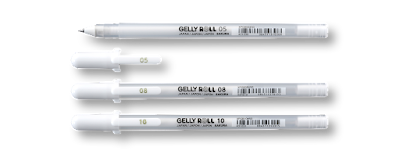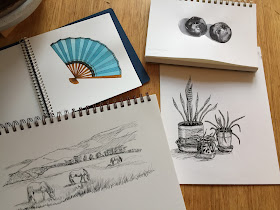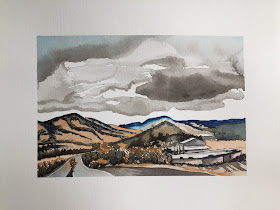A year ago, I decided to try SketchBox, a subscription service that sends you a small box of art supplies every month. I’d been taking a series of Zoom painting classes that had just ended, and I was worried that art would drift out of my life if I didn’t have some stimulation coming in regularly to challenge me. (I’m the kind of person who never goes to the gym unless a tennis partner or class instructor is waiting for me, foot tapping with impatience.)
There are lots of these subscription companies—ArtSnacks, ScrawlrBox, and Let’s Make Art, to name a few—but I decided on SketchBox because the ads had beautiful art, the materials seemed varied and high-quality, and it wasn’t aimed at kids; there were no hobbit houses or cartoon dogs in the ads. SketchBox has two tiers—a Basic Box at $25/month + $5 shipping, and a Premium Box at $35 + $5, which has everything from the Basic Box plus a few extras. I sprang for the Premium Box because I knew I’d always wonder what extras I was missing out on if I got the Basic Box. I steeled myself for that $40/month payment; I’m not made out of money, and this seemed like kind of a loony extravagance. But I didn't have any more painting classes lined up, I was curious about SketchBox, and I knew I could cancel it at any time if it wasn’t my thing.
And now it’s a whole year later, and I’ve received a full year of SketchBox boxes. What's the verdict?Read on.
What I love about SketchBox
• You don’t know what will be in each month's box. No clue. I didn’t think I’d like that—you’re shelling out $40 a month, and you don't know what you're getting? But they smartly send you an email when it’s shipped, and that gives you 3–5 days for the excitement to build, and then it arrives, and—I’ve got to say, it’s exactly like getting a Christmas present. Every month, I tore into that box with glee. Not knowing what to expect makes it . . . better.
 |
| The February box was tinted graphite. |
• With every box you get a link to an online video tutorial showing you how to use everything in the box. This was great—full of tips and techniques. (Ask me all about swatching.) Some other box subscriptions offer instructions in magazine format, but I would much rather have a video. I only wish they were a little longer.
• SketchBox usually includes a pad of paper, again often from Europe or Japan. Some other subscription services don’t do this; I’m sure it reduces their costs and subscription fee, but I love trying out different papers. My one quibble is that the paper is always 4 inches wide to fit in the SketchBox shipping carton. I'd love to occasionally get a larger pad, 6x9 or 8x8.
• One of my favorite things has turned out to be the SketchBox online community—it's large and active, and those connections have led me to other opportunities. Through posting and tagging my artwork that I made with the SketchBox supplies, I've found other SketchBox artists on Instagram, who talk about online instructors they like, many of whom have free tutorials on Youtube. And because several of my new Instagram contacts are in Germany, their posts are in German, and so are the video tutorials they recommend—which gives me a chance to brush up on my German, something else I haven’t used in 30 years.
Not so hot
Did I love every one of the 12 SketchBoxes I got this year? Honestly, no. There were a few supplies that didn’t grab me. I’ve tucked them away in hopes that I'll warm to them one day, and because SketchBox tends to mix supplies, no box was a complete fail; there was always something I liked in it. But for me, the duds were:
• Alcohol markers. These are very hot right now, and some artists do amazing things with them. I’m just not one of them, and don’t have much patience for these. They also require special paper that they won’t bleed through. And they smell weird, like slightly dangerous fruit juice.
• Oil pastels. One summertime box was all about oil pastels, five colors in very nice European brands, along with three small canvases. But I just can’t with oil pastels. They’re messy and inexact. And they also smell funny, like old crayons.
• Metallic and pearlescent paints. These seem to be popular, but I’m not sure why. Sure, you can paint something cool with them—you can mix colors just like any watercolor—but then you turn it to the light and go, “What the f***—why so glittery?” I'm clearly the wrong audience for these.
 |
| Accept no substitutes. |
Seemed silly; ended up cool
• Every once in a while, a SketchBox includes . . . a pencil. Usually a European-made one, kinda fancy. I laughed the first time I got one, rattling around loose in the box—like, who doesn’t have a jillion pencils? But I've come to really like these. Some have hard lead and are good for light sketching that won’t show under a watercolor. Others are dark and smooth and are good drawing pencils all by themselves. There’s something to be said for good pencils, and they now have a special place in my drawer. I feel a certain calm reverence when I use a pencil made in Switzerland.
 |
| Get one. Seriously. |
• All of the brushes. Come on, if you’ve painted for any time at all, you probably have about a thousand brushes. But SketchBoxes often include one lone brush, an unusual shape or size that I probably wouldn’t normally buy—a chisel blender, a dagger, or a filbert—because they’re sort of luxurious and unnecessary. The kind of thing you might get—wait—as a Christmas present! I love them all now.
Dreaming on
To conclude, I loved this year with SketchBox. And I don’t feel like I’ve quite had my fill of it, so I’ll continue my subscription for a while. I figure they’ll probably start repeating themselves at some point, but I like to think about what surprise might be in the next box. And there are a few things I wish they’d include, done up SketchBox-style, a fancy European or Japanese version of:
• Kneaded eraser
• Sand eraser
• More mouth-watering watercolors from Stoneground
• Samples of European watercolors I’ve been wanting to try: Gallo, Roman Szmal, Nevskaya Palitra, Sennelier, Maimeri
• Fountain pen
• Nib pen
And sticking with SketchBox will keep me from trying those non-art subscription services that now keep popping up in my Facebook feed like weeds—international snacks, cosmetics, coffee, spices, whisky. (Wait—the whisky one. Hmm . . .)
 |
| Made with the November box—Gansai Tambi watercolors and Color Sparx Watercolor Powder. |
* Many watercolorists shun this—adding white with a marker or gouache. Personally, I’ll only do it if the painting isn’t working and I’ve screwed it up somehow; then I’ll have at it with whatever markers are at hand just to see what happens. I’ve actually ended up with some good paintings this way.








